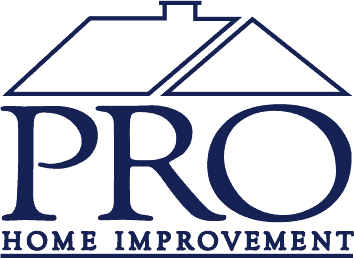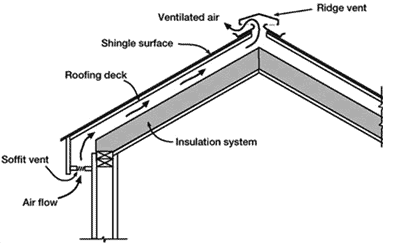Roof ventilation is one of the most misunderstood and yet most important features of any roofing system. A properly ventilated roof compared to one that is not properly ventilated can be 10-20 years of additional service. Yes, a roof can fail at only 25% of its expected life because of improper ventilation. How does this happen and what causes it? Ice dams, mold and high electrical bills can all result from ineffective ventilation for your roof.
Lifespan of a Roof
The premise behind good ventilation is that the space below your roof surface, your attic, stays as close to the outside air temperature as possible. When the outside temperature is not close to the inside temperature, what can happen is similar to what you see on a cold beverage in a glass outside on a humid day; condensation. Warm, humid air from inside your home can condense on the underside of your roof, causing moisture and mold issues. Also, during the winter months, when the attic remains too warm due to poor ventilation and insulation, the roof heats up and melts snow, which later refreezes at the roof edge, causing ice damming. This leads to shingles pulling up, leaks and broken gutters.
Getting your attic space as close as possible to the external roof temperature will help maintain your roof material and decking for the duration (or longer) of its rated life.
Saving Energy
Ventilation in your attic affects your utility bills also. When you can keep your attic space cool during the summer months, this removes a major source of heat on the ceiling of your home. Less heat load on your home leads to your air conditioner having to run less often, saving you a ton of money in electrical bills, since the air conditioning can be the highest user of electricity during the summer. For this to truly be effective, good ventilation must be combined with effective insulation and vapor barrier in the space between your living area and the attic.
Mold and Moisture
Keeping an attic space dry through good ventilation will keep you safer from a buildup of moisture, which can lead to mold. Discovering mold in your attic is not fun, since mold remediation can be a very long and expensive process. It’s worthwhile to spend some time ensuring it never takes place in your attic.
Moisture can build up from inside your home from all of the bathing, breathing and cooking that occurs. This moisture tends to travel upwards toward your attic. Having a vapor barrier in place will prevent a majority of this moisture from getting into the attic. When some moisture does make it inside your attic, proper ventilation helps to move that out of the attic space before it can do any harm.
Check Your Ventilation System
All of these advantages demonstrate that getting enough ventilation for your attic is a very important step when evaluating your replacement roof options. Make sure you ask your roofing professional about the ventilation systems they usually use, because they will affect the lifespan of your roof. Pro Home Improvement knows exactly what type of ventilation system to use based on the type of roof you have. They use industry-leading technologies for replacing and installing new roof systems and ensuring they are properly ventilated.

